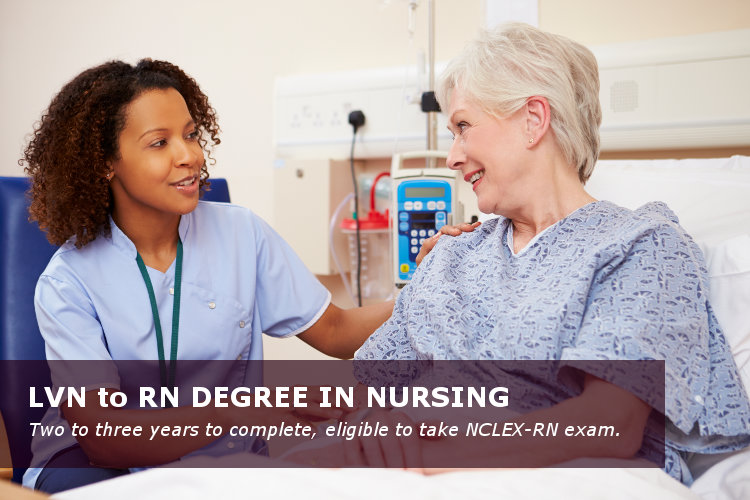LVN to RN Bridge Programs Explained

Overview
What Is an LVN to RN Bridge Program?
An LVN to RN bridge program is a streamlined academic path for the Licensed Vocational Nurse (LVN) in California and Texas who wants to become a Registered Nurse (RN). These programs are built to recognize the nurse's prior education and clinical experience, helping them transition into RN-level practice more efficiently than starting from a traditional nursing program.
Most LVN to RN programs lead to an Associate Degree in Nursing (ADN or ASN), though some offer a direct route to a Bachelor of Science in Nursing (BSN). Upon graduation, students are eligible to sit for the NCLEX-RN exam, which is required to become a licensed RN.
Bridge programs may be available at community colleges, technical schools, and select universities. Flexible options such as evening, weekend, or hybrid courses help Vocational Nurses continue working while advancing their education.
LVN to RN Program Overview:
- Designed for LVNs seeking RN licensure in California and Texas.
- Most programs award an Associate Degree in Nursing (ADN or ASN).
- Graduates are eligible to take the NCLEX-RN exam.
- Program duration is typically 12 to 24 months.
- Available in full-time, part-time, and hybrid formats.
- Coursework includes lectures, lab work, and hands-on clinicals.
- Credits may transfer into a future RN to BSN program.
Admissions
What Are the Admission Requirements for an LVN to RN Program?
To enroll in an LVN to RN bridge program, applicants must hold an active and unrestricted Vocational Nurse (LVN) license. These programs are intended for working LVNs in California or Texas who wish to advance to Registered Nurse (RN) status through a degree-granting track.
Although specific requirements vary by college, most programs ask candidates to meet the following criteria:
- Complete an application and pay any associated fees.
- Hold a valid, unrestricted LVN license in good standing.
- Submit official transcripts from an approved vocational nursing program.
- Meet GPA requirements (often a 2.5 minimum).
- Achieve a qualifying score on a nursing entrance exam (TEAS or HESI).
- Provide documentation of physical health and required immunizations.
- Undergo a criminal background check and drug screening.
- Maintain CPR certification for healthcare providers.
Some programs may favor applicants with recent LVN work experience or require a certain number of hours in direct patient care. Due to high demand, many schools use selective admissions processes or maintain competitive waitlists.
Curriculum
What Does the LVN to RN Curriculum Cover?
LVN to RN bridge programs are structured to build on the knowledge and clinical experience of Licensed Vocational Nurses. These programs prepare students for RN licensure through a focused curriculum in nursing theory, laboratory skills, and hands-on clinical rotations. Most programs take 12 to 24 months and lead to an Associate Degree in Nursing (ADN) or Associate of Science in Nursing (ASN).
The sample curriculum below outlines a common full-time, two-year track offered by California and Texas colleges:
| Term | Courses | Clinicals |
|---|---|---|
| Year 1 | ||
| 1 |
|
|
| 2 |
|
|
| Year 2 | ||
| 3 |
|
|
| 4 |
|
|
* Source: Sample curricula from accredited LVN to RN programs in California and Texas community colleges.

Clinicals
What Clinical Training Is Required in an LVN to RN Program?
LVN to RN bridge programs include hands-on clinical rotations that help Vocational Nurses develop the competencies expected of a Registered Nurse. Clinicals are completed in licensed healthcare settings such as hospitals, rehabilitation centers, long-term care facilities, and public health clinics.
Training begins early in the program and expands in complexity with each academic term. Students progress from basic care and assessment tasks to more advanced roles involving medication administration, care planning, and collaboration with the healthcare team. The final term includes a preceptorship that simulates real-world RN practice under the guidance of an experienced nurse.
Below are common types of clinical experiences in a two-year LVN to RN bridge program:
- Nursing Fundamentals Lab. Focuses on essential nursing techniques including hygiene care, infection control, bed making, and patient mobility.
- Medical-Surgical Clinical. Introduces students to acute care settings where they provide care to adults with medical and surgical conditions.
- Long-Term Care Rotation. Emphasizes geriatric nursing and the management of chronic illnesses in skilled nursing facilities or assisted living environments.
- Psychiatric Nursing Clinical. Covers communication skills, behavioral health interventions, and therapeutic strategies for patients with mental health needs.
- Maternal-Child Clinical. Includes rotations in labor and delivery, postpartum units, and pediatric care, focusing on family-centered nursing.
- Capstone Clinical Experience. Allows students to synthesize knowledge in a comprehensive rotation involving full patient loads and shift-level duties.
- Preceptorship Assignment. A mentored placement where students shadow and assist a practicing RN, bridging the gap between student and licensed nurse roles.
Most programs require 500 to 700 supervised clinical hours for graduation. These hours must be completed in person and often include both day and evening shifts, depending on the site placement.
Tuition Cost
How Much Does an LVN to RN Program Cost?
LVN to RN programs are typically offered through public community colleges, vocational schools, and some state universities in California and Texas. Because these bridge programs build on prior education and experience, they often require fewer credits than a traditional RN program, making them more affordable and faster to complete.
Tuition rates depend on your residency status and the institution you choose. Most public programs in California and Texas charge between $5,000 and $15,000 for in-state students. Private schools may charge more, especially if they offer accelerated or hybrid formats.
Sample in-state tuition estimates for LVN to RN programs include:
- California: $6,500
- Texas: $7,200
- Nevada: $8,300
- Arizona: $9,000
- New Mexico: $9,800
Additional costs may apply for lab fees, scrubs, textbooks, liability insurance, health screenings, and the NCLEX-RN exam. Many schools offer financial aid or payment plans, and working vocational nurses may qualify for employer tuition reimbursement.
Outcomes
What Can You Do After an LVN to RN Program?
Completing an LVN to RN program qualifies you to take the NCLEX-RN and apply for licensure as a Registered Nurse. As an RN, you'll be eligible for positions in hospitals, clinics, home health agencies, rehabilitation centers, and long-term care settings throughout California, Texas, and beyond.
While some employers prefer candidates with a Bachelor of Science in Nursing (BSN), many continue to hire associate-prepared nurses, especially in regions with nursing shortages or where LVNs already have hands-on experience. With time and continued education, graduates can also take on greater responsibility or explore specialty areas of care.
Career paths commonly pursued by LVN to RN graduates include:
- Pediatric Nurse
- Medical-Surgical Nurse
- Labor and Delivery Nurse
- Ambulatory Care Nurse
- Preoperative Nurse
- Wound Care Nurse
- Dialysis Nurse
- Emergency Room Nurse
- Charge Nurse
- … and many more
Is an LVN to RN program worth it? Absolutely. It's one of the most efficient ways to advance from vocational to registered nursing, allowing you to expand your scope of practice, increase your earning potential, and pursue further degrees such as a BSN or MSN.
Last updated: August 7 2025
References:
- Licensed Vocational Nurses. Bureau of Labor Statistics, U.S. Department of Labor, Occupational Outlook Handbook. Retrieved August 7 2025.
- Registered Nurses. Bureau of Labor Statistics, U.S. Department of Labor. Occupational Outlook Handbook. Retrieved August 7 2025.
- What to Expect During Nursing Clinicals. American Nurses Association (ANA), Nursing Education Guide. Retrieved August 7 2025.
- NCLEX Exam Information. National Council of State Boards of Nursing (NCSBN). Retrieved August 7 2025.
- Accelerated Nursing Programs. Education Resources, American Association of Colleges of Nursing. Retrieved August 7 2025.
- Current Tuition. California State University, Undergraduate, Credential, Graduate and Doctoral Programs. Retrieved August 7 2025.
- Student Guidelines and Information. Texas Board of Nursing. Retrieved August 7 2025.
- LVN to RN Transition Nursing Program. Texas State Technical College. Retrieved August 7 2025.
- LVN to RN Programs in Houston. Texas Health School. Retrieved August 7 2025.
- LVN to RN Bridge Option. Navarro College, Texas. Retrieved August 7 2025.
- LVN to RN Degree Options. Long Beach City College, California. Retrieved August 7 2025.
- LVN to RN Associate Degree. College of the Canyons, California. Retrieved August 7 2025.
